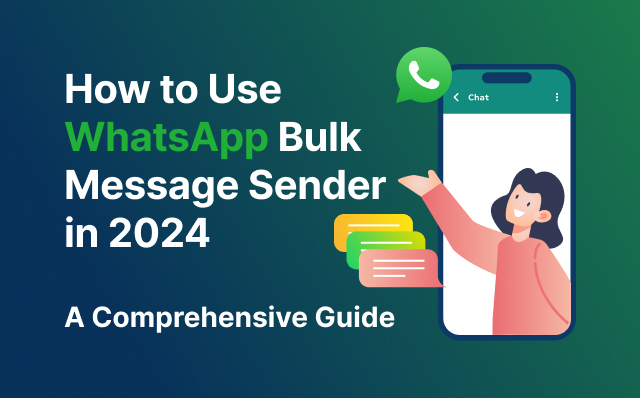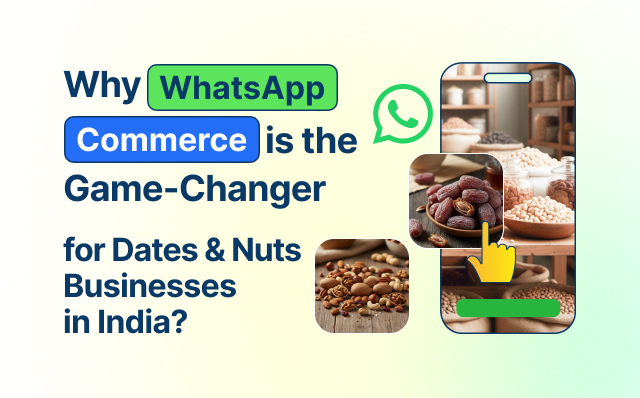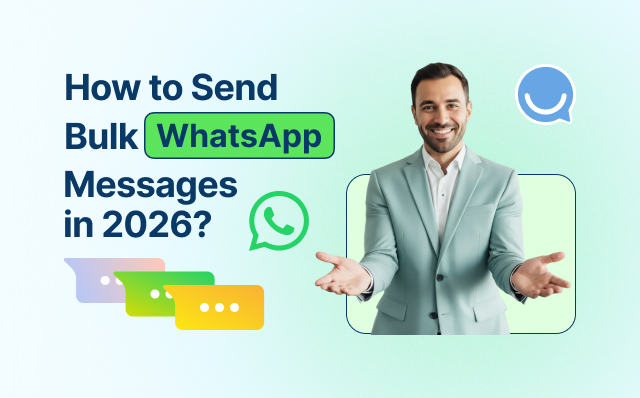In 2024, WhatsApp continues to be a leading communication tool, not just for personal use but also for businesses looking to reach a large audience effectively. One of the most efficient ways to achieve this is by using a WhatsApp Bulk Message Sender. This powerful tool enables businesses to streamline their communication processes, ensuring that important messages, updates, and promotions reach their intended recipients swiftly and without manual effort. But what exactly is a WhatsApp Bulk Message Sender? How does it work? What benefits does it offer over traditional messaging methods? And most importantly, how can you leverage this tool to maximize your marketing efforts and enhance customer engagement?
This comprehensive guide will walk you through everything you need to know about using a WhatsApp Bulk Message Sender, answering these questions and more, to help you harness its full potential in your business strategy.
What is a WhatsApp Bulk Message Sender?
A WhatsApp Bulk Message Sender is a powerful communication tool designed to help businesses send messages to a large number of contacts simultaneously. This tool leverages the capabilities of the WhatsApp API, which allows for the automation and customization of message delivery on a large scale. The WhatsApp API is a robust solution provided by WhatsApp for businesses to integrate with their systems and manage communications efficiently.
This tool is invaluable for businesses that need to communicate efficiently with a broad audience, whether it’s for sending updates, promotions, notifications, or any other type of message. The ability to send bulk messages ensures that businesses can reach their customers quickly and effectively, without the need for manual effort.
Key Features of a WhatsApp Bulk Message Sender
- Automated Messaging: Automates the sending of messages, saving businesses time and resources by eliminating the need to send each message individually.
- Scalability: Capable of handling a large volume of messages, making it suitable for businesses of all sizes, from small enterprises to large corporations.
- Personalization: Allows for the customization of messages with placeholders for names, account details, or other personal information, ensuring each recipient receives a message tailored to them.
- Scheduling: Offers the ability to schedule messages to be sent at specific times, ensuring that communications are sent at optimal times for recipient engagement.
- Analytics and Reporting: Provides insights into message delivery, open rates, and response rates, helping businesses to track the effectiveness of their campaigns and make data-driven decisions.
- Template Management: Enables businesses to create, manage, and reuse message templates, streamlining the communication process.
- Integration Capabilities: Can be integrated with CRM systems and other business tools, allowing for seamless data synchronization and improved workflow.
Benefits of Using a WhatsApp Bulk Message Sender
Time-Saving
One of the primary benefits of using a WhatsApp Bulk Message Sender is the significant amount of time it saves. Automating the process of sending messages to multiple contacts means that businesses no longer have to manually send each message one by one. This is especially beneficial for businesses with large contact lists, as it allows them to communicate with thousands of customers in a matter of minutes. By reducing the time spent on manual messaging, businesses can focus on other critical tasks, enhancing overall productivity and efficiency.
Cost-Effective
Using a WhatsApp Bulk Message Sender can also be highly cost-effective. By automating the bulk messaging process, businesses can reduce the need for additional manpower to manage large-scale communication efforts. This can result in substantial cost savings, as fewer resources are required to achieve the same level of outreach. Additionally, the cost of using a bulk message sender is often lower than other forms of mass communication, such as direct mail or traditional advertising, making it an economical choice for businesses of all sizes.
High Engagement
WhatsApp messages typically have higher open and response rates compared to emails, making them an effective tool for engaging with customers. The instant nature of WhatsApp notifications means that messages are more likely to be seen and read promptly. This high engagement rate ensures that important updates, promotions, and notifications reach the intended audience quickly and are more likely to elicit a response. As a result, businesses can achieve better results from their marketing and communication efforts.
Personalization
A WhatsApp Bulk Message Sender allows businesses to personalize their messages, maintaining a personal touch even when communicating with large groups. By incorporating placeholders for personal details such as names, account numbers, or specific preferences, businesses can create customized messages for each recipient. This level of personalization can significantly enhance the customer experience, making recipients feel valued and appreciated. Personalized messages are more likely to resonate with customers, fostering stronger relationships and loyalty.
Analytics
Another major benefit of using a WhatsApp Bulk Message Sender is the ability to gain valuable insights through analytics. These tools provide detailed reports on message delivery, open rates, and response rates, allowing businesses to track the effectiveness of their campaigns. By analyzing this data, businesses can identify trends, measure engagement, and determine the success of their messaging strategies. This information is crucial for making data-driven decisions and continuously improving communication efforts to achieve better results.
Choosing the Right WhatsApp Bulk Message Sender
Compliance
Ensure that the bulk message sender complies with WhatsApp’s terms and policies. WhatsApp has strict guidelines regarding the use of its platform for bulk messaging. Using a tool that adheres to these rules helps prevent your account from being banned or restricted. Happilee, for example, is a provider that ensures compliance with WhatsApp’s regulations, including obtaining proper permissions for sending messages and respecting user privacy.
Features
Look for a tool with comprehensive features that align with your business needs. Essential features to consider include:
- Message Scheduling: The ability to schedule messages for future delivery, allowing you to plan campaigns in advance.
- Template Management: Options to create, manage, and reuse message templates for consistency and efficiency.
- Integration with CRM Systems: Integration capabilities with customer relationship management (CRM) systems to streamline data synchronization and enhance workflow. Happilee offers these features, making it easier to manage your messaging campaigns and integrate with your existing tools.
Usability
Choose a tool that is user-friendly and easy to set up. A complex or cumbersome interface can hinder your ability to effectively manage your messaging campaigns. The tool should have an intuitive design and straightforward setup process, enabling you to get started quickly and with minimal hassle. Happilee is known for its user-friendly platform, providing clear instructions and helpful documentation to simplify the setup and use of the bulk messaging tool.
Support
Reliable customer support is essential when using any bulk messaging tool. Check if the provider offers robust support options, such as live chat, email support, or phone assistance. A responsive support team can help you resolve any issues quickly and ensure that you get the most out of the tool. Happilee offers reliable customer support to assist you with any questions or problems, ensuring smooth operation of your bulk messaging campaigns.
Cost
Compare pricing plans to find one that fits your budget. Different providers offer various pricing structures based on factors such as the number of messages sent, the number of users, and additional features. Evaluate the cost-effectiveness of each option by considering the value of the features offered and the potential return on investment. Happilee provides transparent pricing with various plans to suit different business needs, helping you find a solution that aligns with your financial constraints.
How to Set Up a WhatsApp Bulk Message Sender
Setting up a WhatsApp Bulk Message Sender involves several key steps to ensure that your bulk messaging campaigns run smoothly. Follow this guide to get started:
Step 1: Choose Your Tool
Selecting the right WhatsApp Bulk Message Sender is crucial for effectively managing your messaging campaigns. Here are the primary options to consider:
- WhatsApp Business API
The WhatsApp Business API is ideal for medium to large businesses that need a robust solution for managing high volumes of messages. It provides advanced features and integration capabilities, making it suitable for businesses looking to streamline their messaging processes and integrate with their existing systems. The API offers greater control and flexibility, allowing for automated responses, personalized communication, and extensive scalability.
- Third-Party Tools
Services like Twilio, WATI, and others offer WhatsApp bulk messaging capabilities. These tools often provide additional features and integrations to enhance your messaging strategy.
Happilee is another leading provider that offers a powerful WhatsApp API solution. Happilee’s platform provides businesses with the ability to send bulk messages, automate communication, and integrate seamlessly with CRM systems. With its user-friendly interface and comprehensive support, Happilee is an excellent choice for businesses seeking a reliable and efficient bulk messaging tool.
Step 2: Register and Set Up
- Sign Up
Begin by creating an account with your chosen WhatsApp Bulk Message Sender provider. This typically involves providing basic information about your business, such as your name, company details, and contact information. You’ll also need to select a suitable plan based on your messaging needs and volume. The sign-up process may include agreeing to the provider’s terms of service and setting up payment information if required.
- API Integration
Once registered, you need to integrate the WhatsApp API with your system. This process involves connecting your business’s backend to the messaging platform, allowing for automated messaging and streamlined communication. Most providers offer detailed setup guides or tutorials to assist with integration. This may involve configuring API keys, setting up webhooks, and ensuring that your system can handle message delivery and responses effectively.
- Verify Number
Verify your business phone number on WhatsApp. This step is crucial as it ensures that your messages are sent from a legitimate source, which helps build trust with your recipients. The verification process typically involves receiving a code on your phone and entering it into the provider’s system. This step may also include submitting business documents or information to confirm your identity and business legitimacy.
Step 3: Import Contacts
- Gather Contacts
Compile the phone numbers of the recipients you wish to reach. Make sure these numbers are accurate, current, and that you have obtained proper permissions to send them messages. Maintaining an updated contact list is essential for effective communication and to avoid issues related to non-compliance with privacy regulations.
- Import List
Import your contact list into the WhatsApp Bulk Message Sender tool. Most tools allow you to upload contacts via spreadsheets (CSV or Excel files) or integrate directly with CRM systems. This step simplifies the process of managing large contact lists and ensures that your messages are sent to the correct recipients. Ensure that your contact list is organized and free of duplicates to avoid sending multiple messages to the same recipient.
Step 4: Create Your Message
- Draft Message
Compose the message you plan to send. Keep it concise, clear, and engaging to capture the recipient’s attention. Ensure that your message aligns with your communication goals, whether it’s for promotions, updates, or notifications. Crafting a well-written message helps in effectively conveying your message and encouraging engagement from your audience.
- Personalization
Include placeholders in your message for personal details such as names or account numbers. This level of customization makes the message feel more personal and relevant to each recipient, improving engagement and response rates. Personalization can significantly enhance the impact of your communication and make recipients feel valued.
- Templates
If using the WhatsApp Business API, create message templates for recurring communications. These templates need to be approved by WhatsApp before they can be used for bulk messaging. Templates help maintain consistency in your messages and streamline the process of sending bulk communications. Ensure that your templates adhere to WhatsApp’s guidelines to avoid approval delays.
Step 5: Send Messages
- Schedule
Decide whether to send your messages immediately or schedule them for a later time. Scheduling allows you to optimize the timing of your messages for better engagement, taking into account factors such as time zones and recipient availability. This feature helps in managing communication more effectively and reaching your audience at the most opportune moments.
- Send
Begin the bulk sending process. Most tools provide real-time tracking and delivery reports, allowing you to monitor the status of your messages and ensure that they are delivered as planned. Tracking delivery status helps in identifying any issues and making necessary adjustments to improve the effectiveness of your campaigns.
Best Practices for Using WhatsApp Bulk Message Sender
1. Obtain Consent
- Ensure Permission: Before sending messages, always ensure that you have explicit permission from recipients. This involves having them opt-in to receive communications from your business, which helps in maintaining compliance with data protection regulations and avoiding spam complaints. Opt-in mechanisms can include subscription forms, sign-up lists, or confirmation via email or SMS.
- Maintain Records: Keep records of consent to demonstrate compliance if questioned. This can include timestamps, methods of consent, and the content of consent forms.
2. Personalize Content
- Tailor Your Messages: Personalizing messages increases their relevance and effectiveness. Use recipient names, account details, or other personal information to make your communications feel more engaging and tailored. Personalized messages can improve open rates and encourage higher interaction.
- Dynamic Content: Utilize dynamic content features, if available, to create messages that adapt based on recipient data, such as past purchases or browsing behavior. This enhances the recipient’s experience and makes your messaging more impactful.
3. Monitor Performance
- Track Analytics: Leverage the analytics and reporting features of your WhatsApp Bulk Message Sender tool to track the performance of your campaigns. Key metrics to monitor include delivery rates, open rates, click-through rates, and response rates.
- Make Adjustments: Use the insights gained from performance metrics to refine your messaging strategies. Adjust content, timing, and frequency based on what works best for your audience to continually improve your campaign effectiveness.
4. Avoid Spamming
- Manage Frequency: Be mindful of how often you send messages. Overloading recipients with too many messages can lead to frustration and opt-outs. Establish a balanced messaging schedule that respects your audience’s preferences and avoids overwhelming them.
- Relevant Content: Ensure that the content you send is relevant and valuable to the recipients. Avoid sending irrelevant or excessive promotional messages that may be perceived as spam.
5. Follow WhatsApp Policies
- Adhere to Guidelines: Familiarize yourself with and strictly adhere to WhatsApp’s policies and guidelines regarding bulk messaging. This includes rules on message content, frequency, and recipient consent.
- Avoid Penalties: Non-compliance with WhatsApp’s guidelines can result in penalties, including account suspension or banning. Regularly review WhatsApp’s policy updates to ensure ongoing compliance.
Conclusion
In 2024, harnessing the power of a WhatsApp Bulk Message Sender can significantly elevate your communication strategy. This tool offers a streamlined way to reach a large audience with personalized, targeted messages, enhancing both efficiency and effectiveness. By selecting the right sender tool, such as the WhatsApp Business API or a reputable third-party provider like Happilee, and adhering to best practices, businesses can achieve impactful results in their marketing campaigns.
Key Benefits:
- Enhanced Efficiency: Automate and expedite communication processes, saving valuable time and resources.
- Improved Engagement: Craft personalized messages that resonate with recipients, fostering greater interaction and engagement.
- Data-Driven Insights: Utilize analytics to monitor performance and make informed adjustments, optimizing your messaging strategy for better outcomes.
- Cost Savings: Reduce the need for extensive manpower and operational costs associated with manual messaging efforts.
Compliance and Optimization:
- Follow Guidelines: Adhering to WhatsApp’s policies is crucial to avoid penalties and ensure smooth operations. Regularly review these guidelines to stay compliant and avoid issues.
- Continuous Improvement: Use performance metrics to refine your approach continually. This ongoing process of evaluation and adjustment will help you stay ahead in your messaging efforts, improve customer satisfaction, and drive better business results.
Incorporating a WhatsApp Bulk Message Sender into your communication strategy not only enhances your ability to reach a broad audience but also ensures that your messages are delivered effectively and efficiently. By focusing on personalization, compliance, and strategic optimization, you can leverage this tool to build stronger connections with your audience and drive your business growth in 2024 and beyond.


